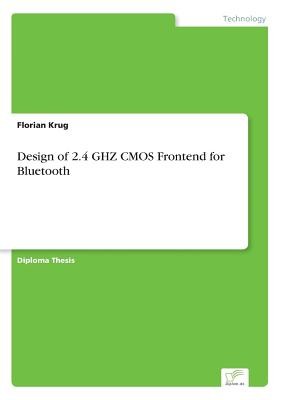
- We will send in 10–14 business days.
- Author: Florian Krug
- Publisher: Diplom.de
- Year: 2001
- Pages: 80
- ISBN-10: 3838641949
- ISBN-13: 9783838641942
- Format: 14.8 x 21 x 0.5 cm, softcover
- Language: English
- SAVE -10% with code: EXTRA
Reviews
Description
Inhaltsangabe: Abstract: The Bluetooth wireless technology is the worlds new short-range RF transmission standard for small form factor, low-cost, short-range radio links between portable or desktop devices. The technology promises to eliminate the confusion of cables, connectors and protocols confounding communications between today high tech products. In the first step a 2.45 GHz Low Noise Amplifier (LNA), intended for use in a Bluetooth receiver, has been designed in a standard 0.18 um CMOS process. The amplifier provides a simulated switchable forward voltage gain of +16 / -7.7 dB with a simulated noise Figure (NF) of only 3 dB while drawing 2.8 mA from a 1.8 V supply. The die area of the LNA (pads included) is 0.79 mm2. In the second step a 2.45 GHz Power Amplifier (PA), also intended for the Bluetooth standard, has been designed in the same 0.18 um CMOS process as for the LNA. The class-A PA achieves a simulated forward gain (S21) of 23 dB and a simulated output 1 dB compression point (P1dB ) of 5.5 dBm, with a power-added efficiency (PAE) of 23 % while drawing 15.8 mA from a 1.8 V supply. The die area of the PA (pads included) is 2.1 mm2. Inhaltsverzeichnis: Table of Contents: 1.Introduction1 1.1Motivation1 1.2Organization2 2.The Bluetooth standard3 2.1Bluetooth as branding-name3 2.2Bluetooth RF requirements4 2.3System design4 2.3.1Receiver architectures4 2.3.2Transmitter architectures6 3.RF CMOS technology9 3.1The foundry9 3.1.1Technology overview9 3.1.2Process Characteristic9 3.2Design Flow10 3.2.1Cadence10 3.2.2SpectreRF10 4.Integrated spiral inductors11 4.1View and physical dimension of spiral11 4.2Model for on-chip spiral inductors12 5.Low Noise Amplifier13 5.1Architecture choices13 5.1.1Recent studies13 5.1.2LNA Architectures13 5.1.3Architecture properties14 5.1.4Architecture choice14 5.2A little piece of theory15 5.2.1Standard MOS noise model15 5.2.2Noise Figure16 5.2.3Input impedance16 5.2.4Voltage Gain18 5.2.5S
EXTRA 10 % discount with code: EXTRA
The promotion ends in 19d.05:57:04
The discount code is valid when purchasing from 10 €. Discounts do not stack.
- Author: Florian Krug
- Publisher: Diplom.de
- Year: 2001
- Pages: 80
- ISBN-10: 3838641949
- ISBN-13: 9783838641942
- Format: 14.8 x 21 x 0.5 cm, softcover
- Language: English English
Inhaltsangabe: Abstract: The Bluetooth wireless technology is the worlds new short-range RF transmission standard for small form factor, low-cost, short-range radio links between portable or desktop devices. The technology promises to eliminate the confusion of cables, connectors and protocols confounding communications between today high tech products. In the first step a 2.45 GHz Low Noise Amplifier (LNA), intended for use in a Bluetooth receiver, has been designed in a standard 0.18 um CMOS process. The amplifier provides a simulated switchable forward voltage gain of +16 / -7.7 dB with a simulated noise Figure (NF) of only 3 dB while drawing 2.8 mA from a 1.8 V supply. The die area of the LNA (pads included) is 0.79 mm2. In the second step a 2.45 GHz Power Amplifier (PA), also intended for the Bluetooth standard, has been designed in the same 0.18 um CMOS process as for the LNA. The class-A PA achieves a simulated forward gain (S21) of 23 dB and a simulated output 1 dB compression point (P1dB ) of 5.5 dBm, with a power-added efficiency (PAE) of 23 % while drawing 15.8 mA from a 1.8 V supply. The die area of the PA (pads included) is 2.1 mm2. Inhaltsverzeichnis: Table of Contents: 1.Introduction1 1.1Motivation1 1.2Organization2 2.The Bluetooth standard3 2.1Bluetooth as branding-name3 2.2Bluetooth RF requirements4 2.3System design4 2.3.1Receiver architectures4 2.3.2Transmitter architectures6 3.RF CMOS technology9 3.1The foundry9 3.1.1Technology overview9 3.1.2Process Characteristic9 3.2Design Flow10 3.2.1Cadence10 3.2.2SpectreRF10 4.Integrated spiral inductors11 4.1View and physical dimension of spiral11 4.2Model for on-chip spiral inductors12 5.Low Noise Amplifier13 5.1Architecture choices13 5.1.1Recent studies13 5.1.2LNA Architectures13 5.1.3Architecture properties14 5.1.4Architecture choice14 5.2A little piece of theory15 5.2.1Standard MOS noise model15 5.2.2Noise Figure16 5.2.3Input impedance16 5.2.4Voltage Gain18 5.2.5S


Reviews